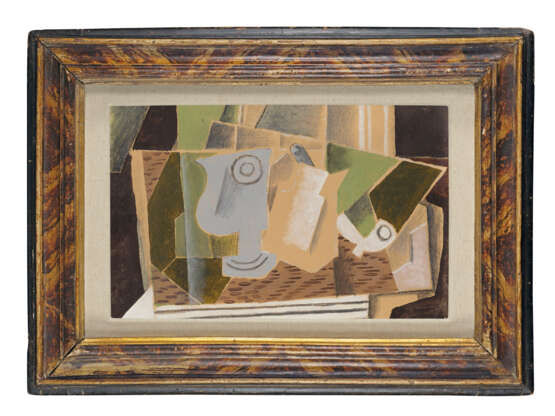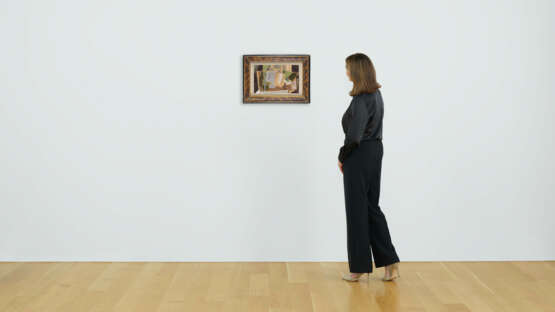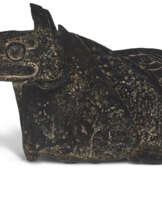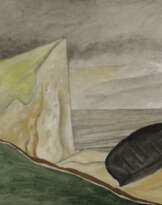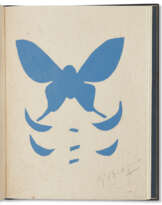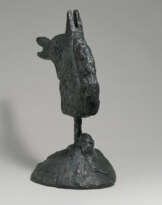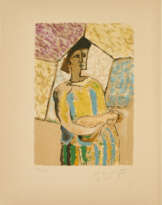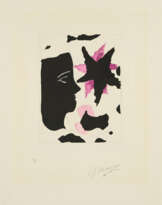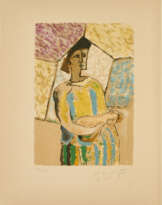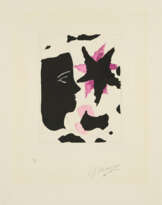ID 1053056
Lot 307 | Georges Braque (1882-1963)
Estimate value
€ 400 000 – 600 000
Verre, tabac et pipe
signé et daté 'G Braque 17' (au revers)
huile et graphite sur toile
27 x 41 cm.
Peint en novembre 1917
signed and dated 'G Braque 17' (on the reverse)
oil and pencil on canvas
10 5⁄8 x 16 ¼ in.
Painted in November 1917
Provenance
Galerie de l’Effort Moderne (Léonce Rosenberg), Paris.
Collection particulière, France (avant 1957).
Dr. Adolf Walter Jann, Bâle et Zurich (avant 1983).
Galerie d’Art Moderne Marie-Suzanne Feigel, Bâle (avant 1993).
Collection particulière, Suisse (acquis auprès de celle-ci).
Collection particulière, Europe (acquis auprès de celle-ci).
Acquis auprès de celle-ci par la famille du propriétaire actuel.
Literature
Maeght, éd., Catalogue de l’œuvre de Georges Braque, Peintures, 1916-1923, Paris, 1973, p. 12 (illustré).
Exhibited
Castres, Musée Goya, Les plus belles peintures contemporaines des collections privées du Tarn, été 1957, no. 4 (illustré, pl. 11; titré 'Verre d'eau'; daté 'vers 1917').
Further details
Mobilisé en 1914, Georges Braque est sévèrement blessé pendant la Première Guerre mondiale sur le front d’Artois en 1915 et ne reprend la peinture qu’en 1917. Il continue alors à explorer les ressources du cubisme, tandis que Picasso, son allié d’autrefois, évolue déjà dans d’autres mouvements. La « cordée en montagne » s’achève pour les géants du cubisme. Kahnweiler écrit dans ses mémoires : « Picasso m’a souvent dit 'Le cubisme a été un travail d’équipe'. La guerre avait dispersé l’équipe. ». A sa reprise des pinceaux, Braque se consacre exclusivement à la nature morte, approfondissant le cubisme pour en arriver à une forme synthétique. Verre, tabac et pipe, peint l’année de sa reprise, retranscrit parfaitement cette nouvelle recherche, avec notamment une réduction de la palette qui, circonscrite dans des nuances de gris ou d’ocre, masque ainsi le relief de l’objet qui dès lors se fond dans la surface picturale, laissant le soin au spectateur de le chercher et d’en distinguer les formes. Isabelle Monod-Fontaine écrit qu'avec ses natures mortes, Braque atteint «une inexhaustible richesse poétique. Il élève le genre de la nature morte à un niveau inédit de profondeur et de complexité, qui n’a probablement jamais été atteint depuis.» (I. Monod-Fontaine, Georges Braque, Order and Emotion, cat. exp., Andros, 2003, p. 24). La logique stricte et l'élan expérimental du cubisme sont tempérés par un souci accru de symétrie et d'harmonie picturale, rendant les images plus fluides et moins abstraites que leurs homologues cubistes antérieurs. La présente toile est donc d'une importante significative dans la carrière de l’artiste puisqu’elle marque un renouveau chez Braque dans son exploration picturale, mais également car elle est un témoin de ce qu’il vient de vivre dans les tranchées. En effet, importé en France en 1560, le tabac, encore réservé à la consommation masculine, gagne en popularité pendant la guerre puisqu’il est largement distribué aux soldats sur le front, pour les aider à surmonter leur peur. Sa présence sur la toile ne peut donc être une coïncidence et pourrait représenter une sorte de catharsis au vu du traumatisme qu’a subi le peintre pendant la Première Guerre mondiale. Affecté en janvier 1915 au 224e régiment d’infanterie, son régiment est engagé en mai dans la première bataille d’Artois. Le 11 mai, à Neuville-Saint-Vaast, atteint par un éclat d’obus à la tête, il est laissé pour mort. Trépané, il passe quarante-huit heures dans le coma, et lorsqu'il reprend conscience, il reste temporairement aveugle. Sa femme Marcelle se rend à son chevet, en compagnie de Picasso. Braque sera décoré de la Croix de Guerre par la suite.
Conscripted in 1914, Georges Braque was severely wounded during the First World War on the Artois front in 1915 and did not return to painting until 1917. He continued to explore the resources of Cubism, while Picasso, his one-time ally, was already moving on to other movements. Kahnweiler wrote in his memoirs: "Picasso often said to me 'Cubism was a team effort'. The war had broken up the team". When he returned to painting, Braque devoted himself exclusively to still-lives, pushing Cubism to its limits to arrive at a synthetic form. Verre, tabac et pipe (Glass, tobacco and pipe), painted the year he resumed painting, perfectly reflects this new research, with the artist reducing his palette to shades of grey or ochre, thus masking the relief of the object, which then blends into the pictorial surface, leaving it to the viewer to search for it and distinguish its shapes. Isabelle Monod-Fontaine wrote that Braque's still-lives achieved "an inexhaustible poetic richness. He raises the genre of the still life to an unprecedented level of depth and complexity, which has probably never been reached since." (I. Monod-Fontaine, Georges Braque, Order and Emotion, exh. cat., Andros, 2003, p. 24). This painting is therefore of significant importance in the artist's career, since it marks a renewal in Braque's exploration of Cubism, but it is also a witness to what he had just experienced in the trenches. Imported into France in 1560, tobacco, still reserved for men's consumption only, gained in popularity during the war, as it was widely distributed to soldiers to help them overcome their fear. Its presence on the canvas cannot therefore be a coincidence, and could represent a kind of catharsis in view of the trauma the painter suffered during the First World War.
| Artist: | Georges Braque (1882 - 1963) |
|---|---|
| Applied technique: | Oil on canvas |
| Auction house category: | Paintings |
| Artist: | Georges Braque (1882 - 1963) |
|---|---|
| Applied technique: | Oil on canvas |
| Auction house category: | Paintings |
| Address of auction |
CHRISTIE'S 9 Avenue Matignon 75008 Paris France | ||||||||||||||
|---|---|---|---|---|---|---|---|---|---|---|---|---|---|---|---|
| Preview |
| ||||||||||||||
| Phone | +33 (0)1 40 76 85 85 | ||||||||||||||
| Fax | +33 (0)1 40 76 85 86 | ||||||||||||||
| Conditions of purchase | Conditions of purchase | ||||||||||||||
| Shipping |
Postal service Courier service pickup by yourself | ||||||||||||||
| Payment methods |
Wire Transfer | ||||||||||||||
| Business hours | Business hours
|



